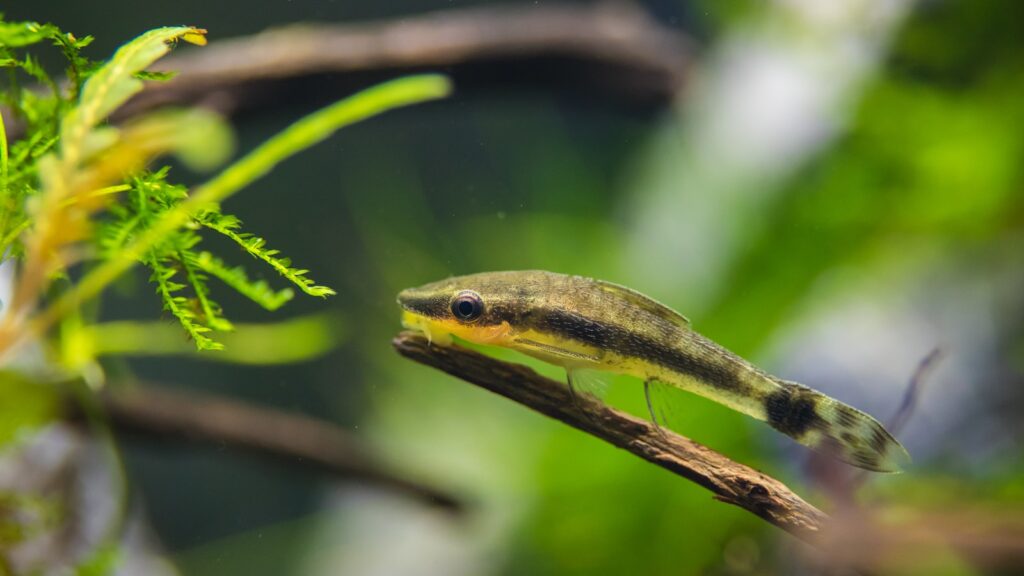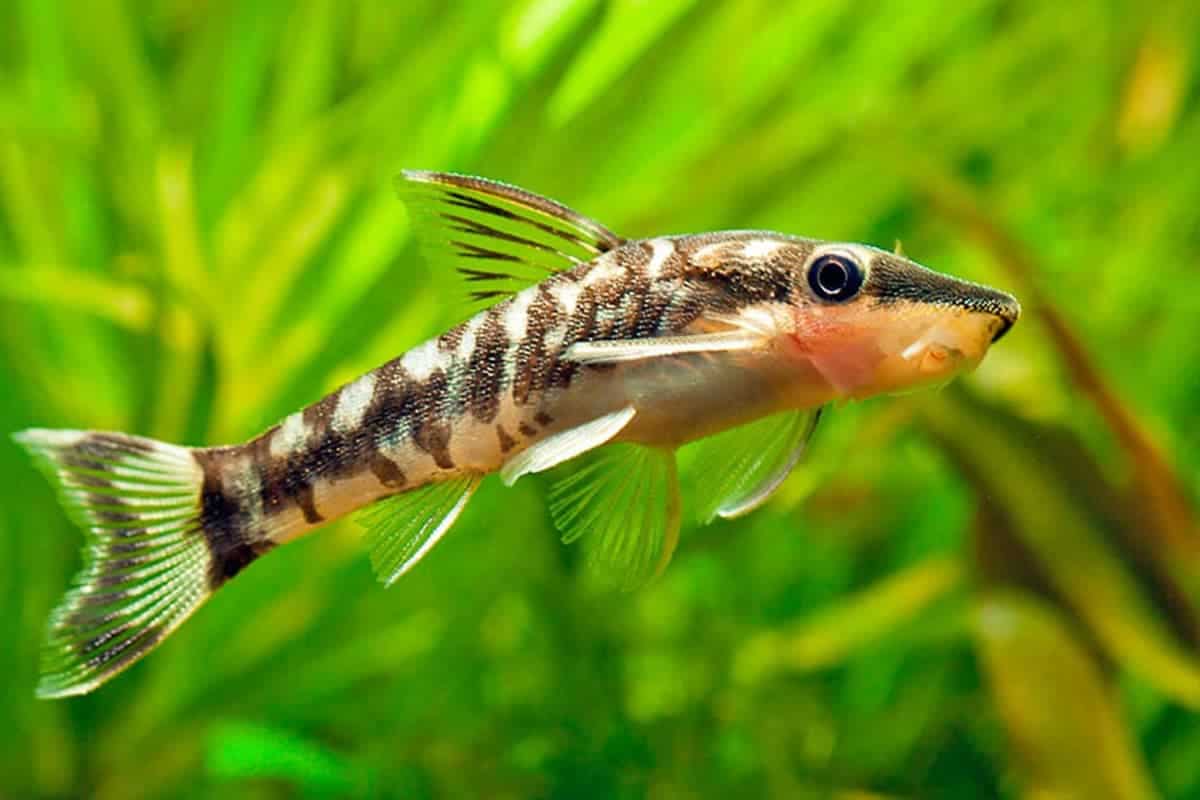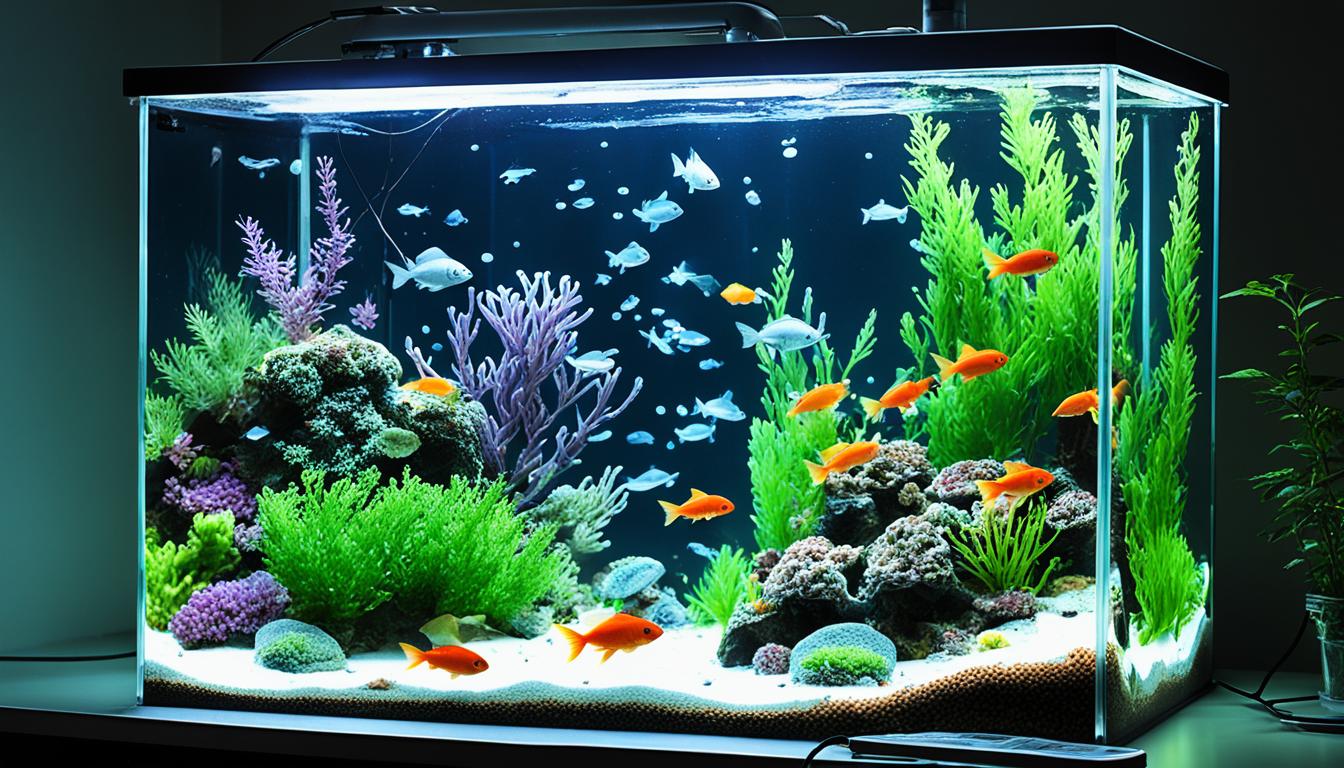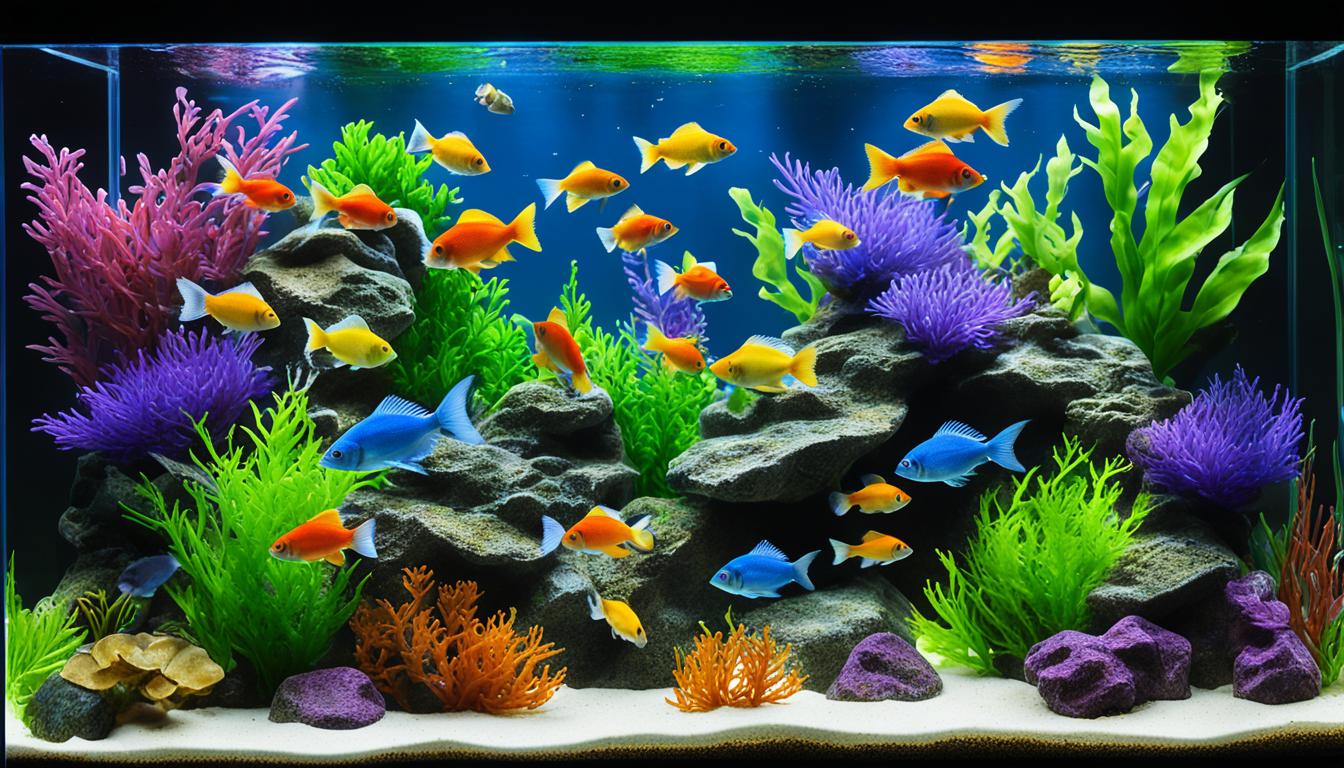Dwarf Otocinclus, commonly known as “dwarf suckers” or “otos,” is a genus of catfish in the family Loricariidae. They are native to South America and have rows of armour plating covering their bodies and an underslung suckermouth.
They can grow up to two inches in length and have a lifespan of around three to five years. Otocinclus fish are herbivores and prefer to eat algae. They are non-aggressive by nature and can do well with most other community tank fish, especially Cory Catfish.
Table of Contents
Tank Setup For Dwarf Otocinclus
Dwarf Otocinclus, also known as “dwarf suckers” or “otos,” are small catfish native to South America. They have rows of armor plating covering their bodies and underslung suckermouths. Otocinclus are non-aggressive and can be kept with most community tank fish, especially Cory Catfish.
They grow up to two inches in length and have a lifespan of around three to five years.
Ideal Tank Size For Dwarf Otocinclus:
- It is recommended to provide a tank with a minimum size of 10 gallons for Dwarf Otocinclus.
- Having a larger tank is always better as it provides more swimming space and helps to maintain stable water conditions.
- A larger tank also allows you to keep a small school of Dwarf Otocinclus, as they are social fish and prefer the company of their own kind.
Water Temperature And Ph For Dwarf Otocinclus:
- The ideal water temperature for Dwarf Otocinclus is between 72°F and 78°F (22°C – 25.5°C).
- The pH level should be maintained between 6.5 and 7.5. It is important to avoid extreme pH fluctuations as it can stress and harm the fish.
Filtration And Water Quality Requirements:
- An efficient filtration system is crucial for keeping Dwarf Otocinclus. They require clean and well-aerated water.
- Use a filter with a low flow rate to prevent the fish from getting stressed by strong currents.
- Regular water changes of around 20% every week are recommended to maintain good water quality and remove any accumulated waste.
Suitable Tank Decorations For Dwarf Otocinclus:
- Provide hiding places for Dwarf Otocinclus by including driftwood, caves, or dense vegetation in the tank.
- Live plants are highly recommended as they not only provide hiding places but also help maintain water quality by absorbing nitrates.
- Avoid sharp decorations that can harm the fish, as they have sensitive bodies with soft skin.
- A sandy substrate or smooth gravel is preferred, as it mimics their natural habitat and allows them to forage for food.
Care And Maintenance Of Dwarf Otocinclus
Dwarf Otocinclus, commonly known as “dwarf suckers” or “otos,” are catfish native to South America. They have rows of armor plating and an underslung suckermouth. With a lifespan of around three to five years, these herbivores are non-aggressive and can be kept with other community tank fish.
They reach a maximum size of two inches.
Dwarf Otocinclus, also known as “dwarf suckers” or “otos,” are small catfish native to South America. If you’re interested in keeping these unique and delightful fish, it’s important to know how to properly care for and maintain their habitat. Here are some essential aspects to consider:
Feeding Requirements And Diet For Dwarf Otocinclus:
- Offer a balanced diet: Dwarf Otocinclus are herbivores, so it’s crucial to provide them with a varied diet rich in algae and other plant matter. Offering a combination of specialized algae wafers, blanched vegetables, and occasional spirulina flakes will keep them happy and healthy.
- Supplement with algae: In addition to their staple diet, it’s beneficial to ensure a good supply of growing algae in the aquarium. This can be achieved by allowing some algae growth on surfaces or introducing live plants for them to nibble on.
- Feed small amounts frequently: Dwarf Otocinclus have a small stomach capacity, so it’s better to feed them small portions multiple times a day rather than a large meal once. This will mimic their natural grazing behavior and prevent overeating.
Maintaining Water Conditions For Optimal Health:
- Keep appropriate temperature: Dwarf Otocinclus thrive in water temperatures ranging from 72°F to 78°F (22°C to 26°C). Maintaining a consistent temperature within this range is essential for their overall well-being.
- Maintain water quality: These catfish are sensitive to poor water conditions, so regular water parameter tests are crucial. Aim for levels of pH between 6.8 and 7.8, ammonia and nitrite levels at zero, and keep nitrate levels below 20 ppm by performing regular water changes.
- Optimal tank size: Dwarf Otocinclus should be housed in a tank with a minimum size of 10 gallons. This allows them to have enough swimming space while also providing a stable environment.
Cleaning And Maintenance Of The Aquarium:
- Regular water changes: To ensure a clean and healthy environment for your Dwarf Otocinclus, perform regular partial water changes of around 25% every week. This will help remove any accumulated toxins and maintain water quality.
- Tank decorations and algae control: Avoid using decorations with sharp edges as they may injure the sensitive underbelly of these catfish. Additionally, control algae growth by maintaining a balanced light duration and providing suitable grazing surfaces, such as rocks or driftwood.
- Gentle substrate cleaning: During water changes, gently vacuum the substrate to remove any uneaten food or debris that may have settled on the bottom. Be cautious not to disturb or stress the Dwarf Otocinclus in the process.
Handling And Acclimating Dwarf Otocinclus:
- Acclimating to new water: When introducing Dwarf Otocinclus to a new tank, it’s crucial to acclimate them slowly to prevent shock. Float their bag in the tank for about 15-20 minutes to equalize the temperature, then gradually introduce small amounts of tank water into the bag every 5-10 minutes until the bag is filled with mostly tank water. Finally, gently release them into the aquarium.
- Avoid excessive handling: Dwarf Otocinclus are delicate fish and should be handled minimally to reduce stress. When necessary, use a soft and clean net to slowly catch them, ensuring you don’t injure their sensitive fins or bodies.
By following these care and maintenance guidelines for your Dwarf Otocinclus, you’ll create an optimal environment for them to thrive and delight you with their small size and unique behaviors. Happy fishkeeping!
Compatibility With Tank Mates
Dwarf Otocinclus, also known as “dwarf suckers” or “otos,” are non-aggressive by nature and can be kept with most other community tank fish. They are especially compatible with Cory Catfish. These tiny fish can grow up to two inches in length and have a lifespan of around three to five years.
Choosing Suitable Tank Mates For Dwarf Otocinclus
When it comes to selecting tank mates for Dwarf Otocinclus, it’s important to consider their peaceful nature and small size. Here are some compatible options:
- Corydoras Catfish: These bottom-dwelling fish have similar care requirements and peaceful personalities, making them great companions for Dwarf Otocinclus.
- Neon Tetras: With their vibrant colors and peaceful temperament, Neon Tetras make excellent tank mates for Dwarf Otocinclus. They also occupy different areas of the aquarium, reducing competition for resources.
- Ember Tetras: These small, active fish add a splash of color to the tank and get along well with Dwarf Otocinclus. They prefer similar water conditions, making them an ideal match.
- Cherry Shrimp: These small invertebrates are peaceful and can coexist peacefully with Dwarf Otocinclus. They also help with algae control in the aquarium.
- Endler’s Livebearers: These small, non-aggressive fish are great tank mates for Dwarf Otocinclus. They have vibrant colors and add liveliness to the tank.
Avoiding Aggressive Or Territorial Fish Species
To ensure a harmonious tank environment for Dwarf Otocinclus, it’s crucial to avoid aggressive or territorial fish species. Here are some fish to steer clear of:
- Cichlids: Most cichlid species are known for their aggression and territorial behavior, which can stress out the peaceful Dwarf Otocinclus.
- Betta Fish: Betta fish are also territorial and may become aggressive towards the smaller Dwarf Otocinclus. Mixing them together can lead to fin nipping and stress.
- Barbs: Many barb species can be nippy and may harass Dwarf Otocinclus. It’s best to avoid including them in the same tank.
- Large Gouramis: Gouramis can be territorial, especially when they are breeding. They may intimidate and attack Dwarf Otocinclus, so it’s best to keep them separate.
Ideal Community Setups For Dwarf Otocinclus
Creating an ideal community setup for Dwarf Otocinclus involves considering their peaceful nature and small size. Here are some recommended community setups:
- Planted Aquarium: Providing plenty of plants not only enhances the aesthetic appeal of the tank but also creates hiding spots for Dwarf Otocinclus. Plants like Java Moss, Anubias, and Amazon Sword are great options.
- Soft Water Setup: Dwarf Otocinclus prefer soft, slightly acidic water conditions. Pairing them with fish that also thrive in these conditions, such as tetras and rasboras, creates a suitable community setup.
- Aquatic Invertebrates: Adding shrimp or snails as tank mates can create a diverse and interesting community setup. Just make sure the invertebrates are compatible with the water parameters and don’t pose a threat to Dwarf Otocinclus.
- Community of Small Fish: Creating a community with other small, peaceful fish like guppies, rasboras, and small tetras can provide a visually appealing and harmonious tank environment for Dwarf Otocinclus.
Remember, when introducing new tank mates to your Dwarf Otocinclus tank, always monitor their behavior and make sure they are compatible in terms of size, temperament, and water conditions.

Breeding Dwarf Otocinclus In The Aquarium
Breeding Dwarf Otocinclus in the aquarium can be a rewarding experience. These tiny catfish, also known as “dwarf suckers” or “otos,” are native to South America. With proper care and a suitable environment, they can thrive and reproduce.
Understanding The Breeding Behavior Of Dwarf Otocinclus
Breeding Dwarf Otocinclus in an aquarium can be a rewarding experience for fishkeepers. To successfully breed these delicate fish, it’s important to understand their breeding behavior. Here are some key points to keep in mind:
- Dwarf Otocinclus are egg layers, meaning they spawn by depositing eggs onto a suitable substrate.
- Breeding usually occurs in the early morning hours when the lights are dim.
- Males actively court females by chasing them and performing a zigzag dance display.
- Females may lay several hundred eggs in small batches over a period of time.
- After spawning, adults typically show little interest in the eggs and may even eat them if given the opportunity.
Creating Optimal Conditions For Breeding
To encourage Dwarf Otocinclus to breed in your aquarium, it’s essential to provide them with the right conditions. Here are some tips for creating optimal breeding conditions:
- Maintain excellent water quality with a temperature range of 75-80°F (24-27°C) and a pH level of 6.5-7.5.
- Provide plenty of hiding places, such as caves, dense plants, or driftwood, to mimic their natural habitat and give the fish a sense of security.
- Use dim lighting or a separate breeding tank to simulate dawn and dusk, which can trigger breeding behavior.
- Offer a varied diet consisting of high-quality flake food, algae wafers, and live or frozen foods like brine shrimp or daphnia. This ensures the fish are well-nourished and ready to breed.
Caring For The Eggs And Fry
Once the Dwarf Otocinclus eggs have been laid, it’s crucial to provide proper care to ensure the survival of the fry. Here’s what you need to know:
- Leave the eggs undisturbed as adult Dwarf Otocinclus may eat them. If they are not in a separate breeding tank, consider removing the adults to prevent predation.
- The eggs usually hatch within 3-6 days, depending on the water temperature.
- Once hatched, the fry will initially rely on their yolk sacs for nutrition. After a few days, they will begin to swim and require tiny, nutritious foods such as infusoria or liquid fry food.
- Regular water changes and the careful removal of any uneaten food or waste will help maintain good water quality for the fry.
Separating Breeding Pairs And Fry From The Main Tank
To ensure the safety and well-being of the breeding pairs and fry, it’s advisable to separate them from the main tank. Here’s how to do it:
- Transfer the breeding pairs to a separate breeding tank or use a breeding net to isolate them within the main tank.
- Provide suitable hiding spots and ample food for the adults in their new environment.
- Once the fry are free-swimming, carefully scoop them out using a fine mesh net and transfer them to a rearing tank.
- The rearing tank should be well-maintained with optimal water parameters and plenty of hiding places for the fry.
- Remember to continue providing appropriate food for the growing fry as they develop.
Breeding Dwarf Otocinclus can be a fascinating and rewarding endeavor. By understanding their breeding behavior, creating optimal conditions, and providing proper care, you can increase your chances of successfully breeding these beautiful fish in your own aquarium.
Common Issues And Troubleshooting
Dwarf Otocinclus, also known as “dwarf suckers” or “otos,” are small catfish native to South America. They have rows of armour plating covering their bodies and underslung suckermouths. These non-aggressive fish can grow up to two inches in length and have a lifespan of around three to five years.
They are herbivores and prefer to eat algae.
Identifying And Treating Common Diseases In Dwarf Otocinclus:
- Ich (White Spot Disease): Small white spots on the body of the fish. Treat with a commercial Ich medication and increase temperature gradually to 86°F (30°C).
- Fin Rot: Fins appear ragged or deteriorating. Improve water quality and treat with an antibiotic medication.
- Dropsy: Bloated appearance with scales sticking out. Treat with a broad-spectrum antibiotic and improve water conditions.
- Parasitic Infections: Fish may display itching or scratching behavior. Treat with a suitable parasite medication.
Dealing With Algae Overgrowth In The Aquarium:
- Ensure proper lighting: Avoid excessive or prolonged exposure to light.
- Control nutrient levels: Limit the buildup of nitrates and phosphates through regular water changes and waste removal.
- Introduce algae-eating fish: Dwarf Otocinclus are natural algae eaters and can help keep growth in check.
- Scrape algae manually: Use an aquarium-safe scraper or brush to remove algae from surfaces.
Addressing Poor Growth Or Lack Of Appetite In Dwarf Otocinclus:
- Check water parameters: Test for ammonia, nitrite, nitrate, and pH levels to ensure they are within the appropriate range.
- Provide a varied diet: Offer a mix of sinking pellets, algae wafers, and blanched vegetables.
- Ensure a peaceful environment: Dwarf Otocinclus can be stressed by aggressive tankmates, so provide a peaceful community setup.
- Monitor for signs of illness: Poor growth or lack of appetite can be indicators of underlying health issues. If symptoms persist, consult a veterinarian.
Remember to always observe your fish closely and take prompt action if you notice any signs of illness or abnormal behavior. Providing optimal care and addressing any issues promptly will help ensure the health and well-being of your Dwarf Otocinclus.

Credit: fisharoma.com
Conclusion
Dwarf Otocinclus, also known as “dwarf suckers” or “otos,” are a popular genus of catfish native to South America. They have rows of armour plating covering their bodies and a unique underslung suckermouth. With a maximum size of two inches and a lifespan of around three to five years, these tiny fish can make a great addition to your aquarium.
Otocinclus are non-aggressive by nature, making them compatible with most community tank fish, especially Cory Catfish. They are herbivores and prefer to eat algae, making them excellent tank cleaners. When adding Otocinclus to your aquarium, it is important to acclimate them properly.
Overall, these small fish offer unique characteristics and can contribute to the overall health and cleanliness of your aquarium. Consider adding Dwarf Otocinclus to your aquatic community for a delightful and beneficial addition.
Frequently Asked Questions On Dwarf Otocinclus
How Big Do Dwarf Otocinclus Get?
Dwarf otocinclus grow to about two inches in length.
What Is The Smallest Otocinclus?
The smallest otocinclus is typically two inches in length. It is commonly known as “Otto fish. “
What Is The Lifespan Of A Otocinclus?
The lifespan of an Otocinclus is around three to five years when kept as a pet.
How Many Otos Should Be Kept Together?
Otocinclus should be kept in a group of 4-6.
Sure, here are 20 FAQs on Otocinclus, with the FAQ marked down as H3 formatting.
What is an Otocinclus?
An Otocinclus, also known as Dwarf Suckermouth Catfish or Oto cat, is a small freshwater catfish species native to South America. They are popular algae eaters in aquariums.
How big do Otocinclus get?
Otocinclus typically grow to a maximum size of around 1.5 to 2 inches (3.8 to 5 cm) in length.
Are Otocinclus schooling fish?
Yes, Otocinclus do best when kept in groups of 6 or more individuals. They are peaceful schooling fish and feel more secure in numbers.
What are the ideal water parameters for Otocinclus?
Otocinclus prefer well-oxygenated water with a pH range of 6.5 to 7.5, a temperature between 72°F to 82°F (22°C to 28°C), and moderate water hardness.
Do Otocinclus need a lot of swimming space?
While not overly active swimmers, Otocinclus appreciate a larger aquarium with plenty of surface area for grazing algae. A minimum tank size of 10 gallons is recommended for a small group.
Are Otocinclus hardy fish?
Otocinclus are generally considered hardy fish, but they can be sensitive to poor water conditions, especially when first introduced to a new tank.
What do Otocinclus eat?
Otocinclus are primarily herbivores and consume algae, biofilm, and aufwuchs (microorganisms) growing on surfaces in the aquarium. They may also accept blanched vegetables and algae wafers as supplemental foods.
Can Otocinclus live with other fish?
Yes, Otocinclus are peaceful and can coexist with other peaceful community fish. However, they may get outcompeted for food by larger, more aggressive fish.
How can I tell male and female Otocinclus apart?
It is challenging to distinguish male and female Otocinclus based on appearance alone. Females may appear slightly larger and rounder when carrying eggs.
Do Otocinclus need special lighting?
Otocinclus do not require special lighting, but they may benefit from moderate to high lighting conditions to promote algae growth, which is their primary food source.
Can Otocinclus be kept in a planted aquarium?
Yes, Otocinclus can be kept in a planted aquarium and may help control algae growth on plant leaves and surfaces.
How long do Otocinclus live?
With proper care and good water quality, Otocinclus can live for 3 to 5 years in an aquarium environment.
Are Otocinclus peaceful fish?
Yes, Otocinclus are generally peaceful and make good tank mates for a community aquarium when kept with other non-aggressive species.
Do Otocinclus need a specific type of substrate?
Otocinclus do not have specific substrate requirements, but a fine gravel or sand substrate is recommended to prevent injury to their delicate bodies.
Can Otocinclus breed in captivity?
While it is possible for Otocinclus to breed in captivity, it can be challenging and requires precise water conditions, appropriate spawning surfaces, and stable water parameters.
What are the signs of a healthy Otocinclus?
Healthy Otocinclus should be active, have a plump body shape, and exhibit good appetite. They should also have clear, unblemished skin and fins.
How often should I feed Otocinclus?
Otocinclus primarily feed on algae and aufwuchs in the aquarium. Supplemental foods, such as blanched vegetables or algae wafers, can be provided every few days.
Do Otocinclus need a lot of water movement?
Otocinclus prefer moderate water movement and filtration, but excessive flow can stress them out. Gentle currents and regular water changes are recommended.
Can Otocinclus be kept in a nano aquarium?
Yes, Otocinclus can be kept in a nano aquarium, provided that it is at least 10 gallons and has suitable water parameters and algae growth for grazing.
Are Otocinclus suitable for beginner aquarists?
Otocinclus can be suitable for beginner aquarists, as they are generally hardy and peaceful. However, their specific dietary requirements and sensitivity to water conditions should be considered.
References
- International Federation of Online Clubs and Aquatic Societies (IFOCAS)
- Federation of British Aquatic Societies (FBAS)
- Northeast Council of Aquarium Societies (NEC)
- Federation of American Aquarium Societies (FAAS)
- Ornamental Aquatic Trade Association (OATA)
I am a passionate aquarist with over 30 years of hands-on experience in fishkeeping. My journey began at a young age, collecting fish from the wild and learning through experimentation. Specializing in tropical fish, I bring a deep understanding of the hobby to FishKeepingMadeSimple. The site provides honest, detailed reviews of essential products and accessories to help fellow enthusiasts create the best environments for their fish.










[…] In this guide, we will discuss how to set up the perfect environment for your Vampire Pleco. From tank size and requirements to water parameters and substrate choices, we will cover everything you need to […]
[…] of providing enough space for your Balloon Mollies and the factors to consider when choosing a tank size for […]
[…] These eggs are transparent and can be scattered on the vegetation or other surfaces within the breeding tank. The male fish will then fertilize the […]
[…] Tank Size Recommendations […]
[…] Tank Size: Approximately 30 gallons per fish […]
[…] are active fish that require enough swimming space to move around freely. They also require a tank that can accommodate their adult size, which varies depending on the pleco […]
[…] a separate breeding tank with a capacity of at least 10 […]
[…] a minimum tank size of 20 gallons, with larger tanks recommended for a group of 3 or more Balloon Mollies. They are […]